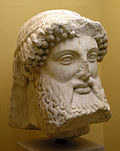Herma

A herma, commonly in English herm, is a sculpture with a head and sometimes a torso, above a tall squared pillar. Often a phallus was carved at the appropriate height.
The form originated in Ancient Greece and was adopted by the Romans and revived in the Renaissance in the form of term figures. The name of the god Hermes comes from the word herma, and the sculptures originally represented him.
The ancient Greeks and Romans were very superstitious, and the sculptures had an apotropiac function. They were placed at cross-roads and on the borders of lands as protection.
In Athens, they were placed outside houses, temples and gymnasiums for good luck and to avert harmful or bad influences, like the evil eye. They would be adorned with garlands, wreaths, offerings and anointed with oil to obtain luck and protection.
Gallery
Attic red-figure lekythos, 475-450 BC, Louvre
Consecration of the herm by Fedor Bronnikov
A bronze herma at the Bardo National Museum
| Wikimedia Commons has media related to Lua error in Module:Commons_link at line 62: attempt to index field 'wikibase' (a nil value).. |
Herma Media
Herma of Demosthenes from the Athenian Agora, work by Polyeuktos, c. 280 BC, Glyptothek
Archaic bearded head of Hermes from a herm, early 5th century BC
Small terracotta herm of Hermes
A hermaic sculpture of an old man, probably a philosopher. Ai Khanoum, Afghanistan, 2nd century BC
Male and female Baroque herms at the Rubenshuis
Medieval herm of King Saint Ladislaus of Hungary that contains his skull; currently in the Cathedral Basilica of Győr









